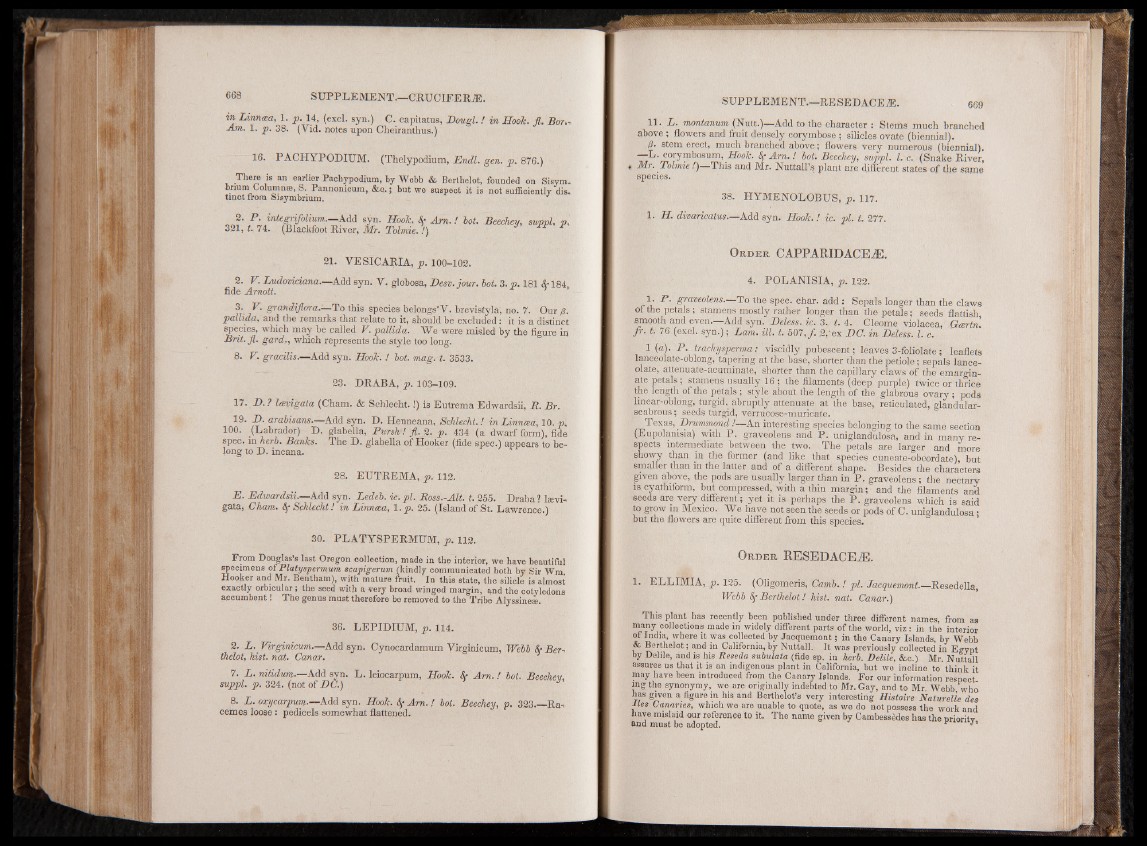
in Linnæa, 1. p. 14, (excl. syn.) C. capitatus, Dougl. ! in Hoolc. fl. Ber„
Am. 1. p. 38. (Vid. notes upon Cheiranthus.)
16. PACHYPODIUM. (Thely podium, Endl. gen. p. 876.)
There is an earlier Pachypodium, by Webb & Berthelot, founded on Sisym.
bnum Columnæ, S. Pannonicum, &o. ; but we suspect it is not sufficiently dis,
tinct from Sisymbrium.
2. P. integrifolium. Add syn. Hook, Sp A m ■ ! hot. Beechey, suvpl, v.
321, t. 74. (Blackfoot River, Mr. Tolmie. !)
21. VE SIC ARIA, p. 100-102.
2. V. Ludoviciana.—Add syn. V. globosa, Desv. jour. hot. 3. p. 181 Sr 184,
fide Amott. ~
3. V. grandiflora.—To this species belongs-V. brevistyla, no. 7. Our /?.
pallida, and the remarks that relate to it, should be excluded: it is a distinct
species, which may be called V. pallida. We were misled by the figure in
Brit.fl. gard,, whiGh represents the style too long.
8. V. gracilis.—Add syn; Hook. ! lot. mag. t. 3533.
23. DRABA, p. 103-109.
17. D.? leevigata (Cham. & Schlecht.!) is Eutrema Edwardsii, R. Br.
19. D. arabisans— Add syn. D. Henneana, Schlecht. / in Linnnea, 10. p.
100. (Labrador) D. glabella, Pursh! fl. 2. p. 434 (a dwarf form), fide
spec, in herb. Banks. The D. glabella of Hooker (fide spec.) appears to belong
to D. incana.
28. EUTREMA, p. 112.
E. Edwardsii.—Add syn. Ledeb. ic. pi. Ross.-Alt. t. 255. Draba ? lævi-
gata, Cham- Sp Schlecht! in Linntea, 1 • p. 25. (Island of St. Lawrence.)
30. PLATYSPERMUM, p. 112.
From Douglas's last Oregon collection, made in the interior, we have beautiful
specimens of Platyspermum scapigerum (kindly communicated both by Sir Wm.
Hooker and Mr. Beiitham), with mature fruit. In this state, the silicle is almost
exactly orbicular; the seed with a very broad winged margin, and the cotyledons
accumbent! The genus must therefore be removed to the Tribe Alyssineee.
36. LEPIDIUM, p. 114.
2. L. Virginicum.—Add syn. Cynocardamum Yirginicum, Webb Sr Berthelot,
hist. nat. Canar. 1
7. L. nitidum-—Add syn. L. leiocarpum, Hook. Sr Am. ! lot. Beechev
suppl. p. 324. (not of DC.)
8. L. oxycarpum-—Add syn. Hook. Sp Am. ! bot. Beechey, p. 323.—Racemes
loose : pedicels somewhat flattened.
11. L. montanum (Nutt.)—Add to the character : Stems much branched
above ; flowers and fruit densely corymbose ; silicles ovate (biennial).
./?. stem erect, much branched above; flowers very numerous (biennial),
—L. corymbosum, Hook. Up Am. ! bot. Beechey, suppl. 1. c. (Snake River,
• Mr. Tolmie!)—This and Mr. Nuttall’s plant are different states of the same
species.
38. HYMENOLOBUS, p. 117.
1. H. divaricatus.—Add syn. Hook. ! ic. pi. t. 277.
Or d e r CAPPARIDACEtE.
4. POLANISIA, p. 122.
1. P. graveolens.—To the spec. char, add : Sepals longer than the claws
of the petals ; stamens mostly rather longer than the petals; seeds flaniab
smooth and even.—Add syn. Deles's. ic. 3., t. 4. Cleome violacea, Gcertn.
fr . t. 76 (excl. syn.); Lam. HI. t. 507, ƒ. 2,-ex DC. in Deless. 1. c.
1 (a). P. trachysperma: viscidly pubescent; leaves 3-foliolate; leaflets
lanceolate-oblong, tapering at the base, shorter than the petiole; sepals lanceolate,
attenuate-acuminate, shorter than the capillary claws of the emargin-
ate petals; stamens usually 16 ; the filaments (deep purple) twice or thrice
the length of the petals ; style about the length of the glabrous ovary ; pods
linear-oblong, turgid,^ abruptly attenuate at the base, reticulated, glandular-
scabrous ; seeds turgid, verrucose-muricate.
Texas, Drummond !—An interesting species belonging to the same section
(Eupolanisia) with P. graveolens and P. unigland ulosa, and in many respects
intermediate between the two. The petals are larger and more
showy than in the former (and like that species cuneate-obcordate), but
smaller than in the latter and of a different shape. Besides the characters
given above, the pods are usually larger than in P. graveolens; the nectary
is cyathiform, but compressed, with a thin margin; and the filaments and
seeds are very different; yet it is perhaps the P. graveolens which is said
to grow m Mexico. We have not seen the seeds or pods of C. uniglandulosa •
but the flowers are quite different from this species.
Or d e r RESEDACEÆ.
1. ELLIMIA, p. 125. (Oligomeris, Camb. ! pi. Jacquemont.—ReseAella,
Webb Sp Berthelot! hist. nat. Canar.)
This plant has recently been published under three different names, from as
many collections mado in widely different parts of the world, viz : in the interior
of India, where it was collected by Jacquemont ; in the Canary Islands, by Webb
& Berthelot ; and in California, by Nuttall. It was previously collected in Egypt
by Delile, and is his Reseda subulata (fide sp. in herb. Delile, See.) Mr. Nuttall
assures us that it is an indigenous plant in California, but we incline to think it
may have been introduced from the Canary Islands. For our information respect
mg the synonymy, we are originally indebted to Mr. Gay, and to Mr. Webb who
has given a figure in his and Berthelot’s very interesting Histoire Naturelle des
Iles Canaries, which we are unable to quote, as we do not possess the work and
have mislaid our reference to it. The name given by Cambessèdes has the nrioritv
and must be adopted. r